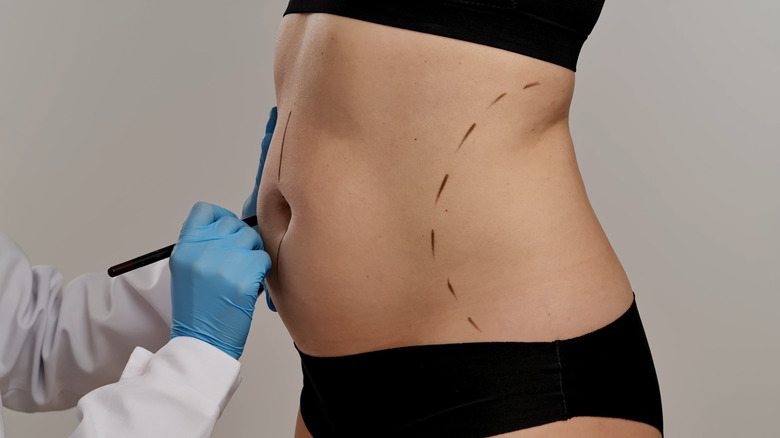These Cosmetic Procedures Have The Shortest Downtime, Per Our Plastic Surgeon
Despite the many positive reviews that surround cosmetic procedures — and the celebrities who have opened up about their plastic surgery experiences and vouched for the process — some people still have reservations. Cosmetic procedures aren't for everyone, but sometimes those who are interested in a little nip and tuck hesitate because of the investment required. Along with the financial cost, the downtime that follows some of the most common treatments is enough to put people off.
But the good news for those who are seeking cosmetic work is that some procedures have less downtime than you'd think. In an exclusive chat with Glam, plastic surgeon Dana M. Goldberg, M.D., revealed that "minimally invasive" procedures don't take long to recover from at all. "Surgical procedures with short downtime generally include procedures that do not involve any muscle or involve incisions near joints," Dr. Goldberg explains. "Most breast lifts, eyelid surgeries, and labiaplasties are one to two weeks of downtime."
Additionally, there are minimally invasive alternatives to more complex procedures that you might want to opt for since they can give you similar results. "An example is doing CoolSculpting instead of liposuction," the plastic surgeon explains. "With CoolSculpting, an applicator is applied to an area of the body, and the tissue is made very cold for 30 to 40 minutes. There is no need for activity restrictions or compression garments, and there is only slight soreness for a few weeks. It can take a few months and multiple treatments to see the final results, but with essentially no downtime, many patients find this a convenient option to reduce fat deposits." Depending on your goals, there may be no choice but to go for a more invasive procedure, but Dr. Goldberg notes that some common skin procedures, in particular, don't have long recovery periods.
Skin treatments and fat transfers can have limited recovery time
One of the most popular treatments with limited downtime is intense pulsed light therapy (IPL) and other non-ablative lasers, which are used for several skin conditions. IPL can also be used to reduce the signs of aging on your hands. "This feels like a sunburn for a few days and can cause temporary worsening of pigment spots for 7 to 10 days, but the discoloration can be covered with makeup," Dr. Dana Goldberg tells Glam exclusively. "This procedure doesn't limit exercise, but it requires patients to be cautious about sun exposure." Dr. Goldberg adds that Ultherapy, "a skin tightening procedure using ultrasound to target the skin and connective tissue," is another minimally invasive procedure. "With no visible downtime or restrictions on activity, many patients do this during the work week and resume life as normal. It can take a few months to see results though," she says. Skincare is one of the general areas where treatments tend to be minimally invasive, so check out these other skin treatments with limited recovery time.
When it comes to fat transfers, which are often used to increase volume in certain areas of the face or other parts of the body, the injection of stem cell fat doesn't require a long recovery period at all. "It doesn't require surgery, so recovery is very easy," Dr. Goldberg shares. "However, the cost can be far more than doing liposuction and fat transfer." That said, the plastic surgeon confirms that recovery time, or lack thereof, doesn't generally influence how much a procedure will cost.
Muscle-tightening procedures and liposuction come with increased downtime
If extensive downtime following a procedure is a deal-breaker for you, there are a few treatments you'll want to avoid. "Procedures that involve tightening muscles (like a tummy tuck) or incisions that go across joints (like arm lifts or thigh lifts) can restrict patients from working for two to four weeks and can limit working out for up to three months," Dr. Dana Goldberg notes in our exclusive chat. "These procedures, as well as procedures like full body liposuction can also cause swelling, soreness, and nerve discomfort that can linger for up to a year."
Though liposuction is one of the most well-known cosmetic procedures, it's not the best choice for those who want to bounce straight back when they leave the recovery room. "With traditional liposuction, thin tubes called cannulas are used to suction fat through small incisions in the skin," Dr. Goldberg explains. "There is leakage of fluid for a few days, which requires either a surgical drain or bulky gauze dressings. There is no exercise for two weeks, and a compression garment needs to be worn for six to eight weeks."
One thing to keep in mind is that even though some procedures have short downtime periods, they need to be carried out multiple times to be effective. "For example, non-ablative lasers have minimal downtime, but they may require two to three sessions to get the same result as an ablative laser, which requires one to two weeks of downtime," Dr. Goldberg warns. So, when you're weighing which procedures fit the best with your lifestyle, take into account how many sessions you'll need, as a repeated minimally invasive procedure may end up taking more time out of your schedule in the long run than a single procedure that requires some downtime.


